Maha Shivaratri 2023 celebration of
Siva and Images, Wishes, Status,
SMS, Messages
Maha Shivaratri or the ‘Great Night of Shiva’ is an annual Hindu festival celebrated in honor of Lord Shiva. According to Hindu calendar devotees of Mahadev or Lord of Lords Shiva celebrate this festival on the new moon day in the month of Maagha. The festival generally falls in the month of February or March and is observed for a day and following night.
Devotees of
Mahadev believes that whoever worship Lord Shiva on this auspicious day with
true devotion gets free from all sins, get blessed with Nirvana or Moksha.
Maha Shivaratri 2023
Maha Shivaratri wishes
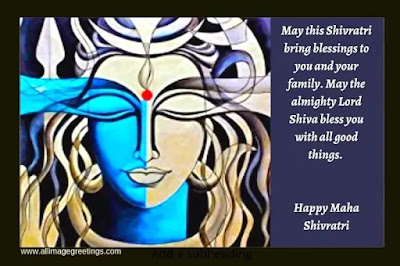 |
maha Shivaratri 2023
Shivratri images
photos of mahashivratri
maha shivratri quotes
shivratri images for whatsapp
maha Shivaratri wishes
maha shivratri quotes
happy Shivratri
photos of mahashivratri
images of Shivratri festival
Shivratri images
Lord Shiva:
Lord Shiva is one
of the most prominent deity of Hinduism. He along with Brahma and Vishnu forms
Devine Trinity or famous Trimurti of Hindu culture. He is called as a destroyer
who destroys the creation when the time comes or when it comes far from goodness to
make it possible for the beginning of new creation.
According to
Shaibasm (devotees of Lord Shiva) Lord Shiva is the supreme God Lord of lords
that’s why they call him ‘Mahadev’.
According to some old scripts, Shiva is the param Ishwar who is formless. They said everything generated from Shiva and everything ends in Shiva. Today’s modern science also says that everything comes from nothing and goes back to nothing and according to Hindu philosophy this nothing is Shiva.
According to mythology he lives a simple life
in Mount Kailash with his family and spends in maximum time in meditating for
welfare of human beings. Old texts described him as a well-built man wearing a
tiger skin, bids of Rudraksha as neckless, ambulate, wristlet and head gear.
His hair is pulled in a Jata and adorn with half-moon. His body adorns with
ashes and a snake in bluish neck. We always see him with a trident or Trishul
and Domru.
But in maximum
cases we worship him as his infinity form or Linga form.
Shiva is a yogi,
destroyer of evil, but he has some other aspects also like the acentric
performer of Dance (Nataraj), the epitome of truth and beauty and fearless
warrior.
Other names
of Lord Shiva:
According to Shiva
Puran Lord Shiva has 108 names. These names along with their meaning are
mentioned below.
1.
Shiva:
Always Pure
2. Maheshwar: Lord of Gods
3. Shambhu: One Who Bestows Prosperity
4. Pinakin: One who has a bow in his hand
5. Shashi Shekhara: The God Who Wears the Crescent Moon in His Hair
6. Vamadeva: The God Who Is Pleasing and Auspicious in Every Way
7. Virupaksha: God with Oblique Eyes
8. Kapardi: The Lord with Thickly Matted Hair
9. Nilalohita: The One With Red And Blue Colour
10. Shankara: One Who Gives Happiness And prosperity
11. Shulapani: The One Who Carries A Trident
12. Khatvangi: The God Who Carries A Knurled Club (Khatvanga)
13. Vishnuvallabha: The One Who Is Dear To Lord Vishnu
14. Shipivishta: The Lord Whose Form Emits Great Rays Of Light
15. Ambikanatha: Consort of Ambika (Parvati)
16. Shrikantha: Of Glorious Neck
17. Bhaktavatsala: The One Who Is Favourably Inclined Towards His Devotees
18. Bhava: The God Who Is Existence Itself
19. Sharva: Remover of All Troubles
20. Trilokesha: The Lord of All the Three Worlds
21. Shitikantha: The Lord Who Has White Neck
22. Shivapriya: Beloved of Parvati
23. Ugra: The One Who Has Extremely Fierce Nature
24. Kapali: One Who Wears A Necklace of Skulls
25. Kamari: Enemy of Kamadeva
26. Andhakasura Sudana: The Lord Who Killed the Asura Andhaka
27. Gangadhara: The God Who Holds the Ganges River in His Hair
28. Lalataksha: One Who Has an Eye in The Forehead
29. Kalakala: He Is the Death of Death
30. Kripanidhi: The God Who Is the Treasure of Compassion
31. Bheema: The One Who Has Fearful Form
32. Parshuhasta: The God Who Holds Axe in Hands
33. Mrigpaani: The God Who Possess Deer in Hands
34. Jattadhar: The God Who Keeps Tress (Jata)
35. Kailashavasi: Native of Kailasha
36. Kawachi: The God Who Possess Armour
37. Kathor: The God Who Has A Strong Body
38. Tripurantak: The God Who Killed Tripurasura
39. Vrishanka: The God Who Has A Flag with A Symbol of Bull
40. Vrishbharudh: The One Who Rides Bull
41. Bhasmodhulitavigrah: The One Who Applies Ashes All Over the Body
42. Samapriya: The One Who Loves with Equality
43. Swaramayi: The God Who Lives in All Seven Notes
44. Trayimurti: The One Who Possess Veda Form
45. Anishvara: The One Who Does Not Have Any Lord
46. Sarvagya: The One Who Knows Everything
47. Paramatma: Everyone's Own Soul
48. Somasuryaagnilochana: The One Who Has Eyes in The Form Of Sun, Moon And Fire
49. Havi: He Who Is Wealthy in The Form of Ahuti
50. Yagyamaya: The Architect of All Sacrificial Rites
51. Soma: The One Who Includes the Form of Uma
52. Panchavaktra: God of The Five Activities
53. Sadashiva: The One Who Is Eternally Auspicious
54. Vishveshwara: Lord of The Universe
55. Veerabhadra: Who Is Violent, Yet Peaceful
56. Gananatha: God of The Ganas
57. Prajapati: The One Who Is the Creator of Dynasty
58. Hiranyareta: The One Who Emanates Golden Souls
59. Durdharsha: The One who Is Unconquerable
60. Girisha: Lord of Mountains
61. Girisha: The God Who Sleeps on Kailash Mountain
62. Anagha: He Who Is Pure
63. Bujangabhushana: Lord Adorned with Golden Snakes
64. Bharga: Lord Who Ends All Sins
65. Giridhanva: God Whose Weapon Is A Mountain
66. Giripriya: Lord Who Is Fond of Mountains
67. Krittivasaa: God Who Wears Clothes of Elephant Skin
68. Purarati: Destroyer OF Town Or "Pur" Named Enemy
69. Bhagwaan: God of prosperity
70. Pramathadhipa: God Who Is Served by Goblins
71. Mrityunjaya: Victor of Death
72. Sukshamatanu: God Who Has A Subtle Body
73. Jagadvyapi: God Who Lives in The World
74. Jagadguru: Guru of All the Worlds
75. Vyomakesha: Whose Hair Spreads in The Sky
76. Mahasenajanaka: Father of Kartikya
77. Charuvikrama: The Guardian of Wandering Pilgrims
78. Rudra: The One Who Gets Sad by The Pain of Devotees
79. Bhootapati: Lord of Panchabhoota Or Bhootapreta
80. Sthanu: Firm and Immovable Deity
81. Ahirbhudhanya: The One Who Possess Kundalini
82. Digambara: The God Whose Robes Is the Cosmos
83. Ashtamurti: Lord Who Has Eight Forms
84. Anekatma: The God Who Possess Many Forms
85. Satvika: Lord of Boundless Energy
86. Shuddhavigraha: Lord of Pure Soul
87. Shashvata: Lord Who Is Eternal and Endless
88. Khandaparshu: Lord Who Wears Broken Axe
89. Aja: The One Who Is Boundless
90. Pashvimochana: Lord Who Releases All Fetters
91. Mrida: The Lord Who Shows Only Mercy
92. Pashupati: Lord of Animals
93. Deva: Lord of Devas
94. Mahadeva: Greatest of The Gods
95. Avayaya: The One Who Never Subject to Change
96. Nilkantha: one who’s throat is blue
97. Bhagnetrabhid: The Lord Who Damaged Bhaga's Eye
98. Avayayat: Shiva Who Is Unseen
99. Dakshadhwarahara: Destroyer of Daksha's Conceited Sacrifice (Yagya)
100. Har: The Lord Who Dissolves All Bondage and Sins
101. Pushadantabhit: One Who Punished Pushan
102. Avyagra: Lord Who Is Steady and Unwavering
103. Sahsraksha:
One Who Has Limitless Forms
104. Sahasrapada: The Lord Who Is Standing and Walking Everywhere
105. Apavargaprada: Lord Who Gives and Takes All Things
106. Ananta: The One Who Is unending
107. Taraka: The Lord Who Is Great Liberator of Mankind
108.Parameshwara:
The Great God
Worshipping
of Lord Shiva:
Lord Shiva is a God
who can be pleased easily. To worship Lord Shiva a person doesn’t need a
priest. Anyone with pure mind and true devotion can worship Shiva. To worship Lord Shiva people can use some
flower, bel patra or bel leaf, bibhuti and if possible Rudraksha.
People generally
visit Shiva temple in Mondays after taking bath and prey to Lord with pure
mind.
Many devotees
chant Maha Mrityunjay Mantra as many time they can.
People generally
abhishek Lord Shiva with water and milk and offer Bel leaf and flowers.
People chant ‘Om
Namah Shibaya’ mantra to please Lord Shiva.
Worshipping
the Shivalinga
In Sanskrit
‘Linga’ means symbol or sign. So, Shiva Linga stands for the sign or symbol of
Shiva. According to some ancient texts Shiva is Adi and Ananta, he is formless.
To mark this formless infinity deity of Hinduism people started to imagine as
pillars and a Shivalinga is a form of Pillar.
In Post Vedic period scholars described Linga as cosmic egg or Shiva’s power of creation. For the shape of Linga they compare it with eggs, from where the Stristi took birth.
According to
scholars a Shivalinga has three parts the lower one Bhrahma-pitha, middle one
as Vishnu-Pitha and the top most part as Shiva-Pitha which represents the holy
and divine Tridev of Hinduism.
We generally
worship lord Shiva in his Lingaa form. The most famous and popular temples of
Lord Shiva such as Kashi Biswswar, Somnath, Kedarnath we can find Mahadev in
his Lingaa avtar.
Though we can find
lots of Shiva Linga throughout the India, Nepal and Srilanka there are few
prominent and special Shiva Linga which are considered as more powerful than
others are
Jyotirlingas:
there are 12 Jyotirlingas present in India. They are Kedarnath, Kashi
Vishwanath, Somnath, Baijnath, Rameswar, Ghrusneswar, Bhimshankar, Mahakal,
Mallikarjun, Amaleshwar, Nageshwar, and Tryambakeshwar.
Pancha-bhuta
Lingas: there are 5 Pancha-bhuta Lingas. They are Kalahastishwar, Jambukeshwar,
Arunachaleshwar, Ekambareshwar of Kanjivaram, and Nataraja of Chidambaram.
Mahashivaratri:
Mahashivaratri ot
Shivaratri is celebrated in the 13th night and 14th day
of month of Phalguna of Hindu Calendar. It is an annual festival which
generally falls in English month February or March according to lunar-solar
calendar.
History
It is difficult to
tell actually from people started to celebrate this festival. Scholars find out
that lots of mediaeval Indian texts and literature described about celebration
of Shiva Ratri for various beliefs and basically to their devotion to Lord
Shiva and seek his blessings. So, though we can’t pin point the particular time
from when the celebration of Shiva Ratri started but obviously can tell this is
a age old culture and centuries old tradition of Hinduism.
Maha
shivaratri Legends and beliefs
There are lots of
stories and beliefs associated with Shiva Ratri. There are lots of folk lores
and mythological beliefs behind the celebration of Shivaratri. We are
discussing them one by one.
1.
Marriage
of Shiva and Shakti:
One
of the most popular belief regarding Shivaratri is that in this day Shiva
married daughter of Himalaya devi Parvati who was recognition of Adi Sakti.
After the divine consort of Shiva Sakti in form of Sati dies Shiva was in
immense grief. First, he performed Tandava and then when the grief subsided, he
Immersed himself in meditation forgetting everything.
Then
all gods preyed to Devi Adi shakti and she reburned as Parvati. She worshiped
Lord shiva for many years with the wish to marry him. After passing so many
hurdles finally they got married and that day is celebrated as Mahashivaratri.
2.
Samudra
Manthan:
People
belief that on this day Lord Shiva saved the world from most dangerous poison
named as Halahal emerged from the ocean as a result of Samudra Manthan by
swallowing in and holding it in his throat. For swallowing this poison his
throat turned blue and the Devatas gave Lord Shiva a new name ‘Nilakantha’
meaning ‘one who’s throat is blue’
3.
Legend
of Shiva Lingaa:
According
to Shiva Puran once on the topic of supremacy there was a huge fight between
Brahma and Vishnu two prominent Gods of Hindu mythology. To see the intensity
of this fight other gods asked Lord Shiva to intervein and solve this problem.
To show them the reality Lord Shiva took form of huge never-ending column of
fire and asked them to find the end of the fiery column. While Brahma went
upwards Vishnu went downwards to find its end.
None of them find the end but while Lord Vishnu said it truthfully
Brahma told a lie that he found the end and been punished for the lie with a
curse that people will not worship him. According to belief the day Shiva took
the form of Linga to show that he is the never-ending source of energy that day
is celebrated as Mahashivaratri.
4.
Dance
of Shiva:
There
is one more popular legend regarding Shivaratri. People of Souther India
believes that on the night of Mahashivaratri Lord Shiva performed his heavenly
cosmic dance of creation, preservation and destruction. In many states of South
India people showed their devotion to Lord of Dance Nataraj by performing
Shiva’s famous tandava and lasya dances.
Mahashivaratri
Stories
There is a popular story associated with Mahashivaratri and why it is celebrated at night.
According to folk
story once upon a time there was a tribal man who was a grate devotee of Lord
Shiva went to forest for hunting birds. He didn’t notice when sun sets and then
he couldn’t find his way back to home. When at night he heard roars of wild
animals he got scared and climbed up a nearby tree. He was so terrified of the
growls of animals that he decided not to sleep that night.
To keep himself
awake he pluck a leaf from the tree and put it down while he chanted name of
Lord Shiva. At sunrise he realized that he was on a bell tree and he has
dropped thousands of bell leaf or bell Patra on a Shiva Lingaa. Lord Shiva was
pleased with this whole night long worship and blessed the tribal man with
divine bliss. Priests tell this story to the devotees in fast on Maha
Shivaratri.
Benefits of
Worshipping Lord Shiva On Mahashivratri
According to
sacred literature of Hindusm Purana Lord Shiva himself declaired that
worshiping him and goddess Parvati on the occasion of Shivaratri while fasting
will bless that person with salvation from his Karma.
It is also been
said that as Shiva is Lord of our body so worshiping him on this night frees
people from Raja guna and Tama guna. Whoever completes the vrat of Shivaratri
with complete devotion get rid of negative feelings such as jealousy, lust,
anger and evil thoughts.
It is believed
that if a married woman observes Shivaratri Vrat mata Gouri and lord Shiva
blessed her with blissful married life while any unmarried girl who observed
the vrat get blessed with a good husband.
Mahashivaratri
and Tantra
Shiva is
considered as Adiguru or Mahayogi who has mastered all kinds of Siddi and Yogas.
He thought humankind the way of meditation and Yog.
Mahashivaratri is
Shiva’s great spiritual night. All the saints and Yogis believes that this is
the holiest night and they can achieve Nirvana by practicing Yoga at this night
as Shiva himself will bless them on this night.
Aghories and
Tantrics practice Tantra and Yoga this night to get blessings of Lord shiva, to
get free from all kinds of Moh maya (materialistic things and relations), to
get Nirvana or Moksh.
Shivratri
celebration
Celebration of
Shivaratri starts from the morning. People takes ceremonial bath in Holy river
Ganga and then went to a temple for morning wearing new cloths. They offer
their prayer with milk, water, bel
leaves, white crown flower, dhutura flower, akanda flower, ganneru flower, fruits,
incense stick, oil lamp etc.
People who
observes the Vrat keeps a strict fast without water also and chant hymes and
mantras of Shiva.
They keep whole night vigil or jagarana and spends the night
by chanting mantras, singing devotional songs and hymes and performing
classical dance forms like Tandava and Lasya of Shiva.
Priests perform
ritual Abhishek of Shivalinga and ceremonial Puja in every 3 hours throughout
the day and night followed.
In big and popular
temples of Shiva a huge number of devotees assemble to prey and pay their
respect and devotion to Lord Shiva.
Shivaratri
Puja
They keep whole night vigil or jagarana and spends the night by chanting mantras, singing devotional songs and hymes and performing classical dance forms like Tandava and Lasya of Shiva.
According to Hindu mythology Shivaratri Puja
has great significance and importance. They believe that the ceremonial worship
and fast in Shivaratri please Lord shiva and whoever please Lord Shiva with his
true devotion and worship gets free from all past sins and gets Moksha or
salvation.
According to Shiva
Puran Shivaratri Puja helps people to get free from materialistic world and
help their spiritual growth.
Shivaratri
puja rituals
According to Shiva
Purana on the day and followed night of Mahashivaratri people should start the
puja by performing abhisheka or ceremonial bath of Shiva Lingaa. It also said
about the 6 essential elements need to perform the ritual. Each of this dravya
or elements have their own significance.
Milk is for the blessing
of purity and piousness, Yogurt is for prosperity and progeny, Honey is for
sweet speech, Ghee is for victory, Sugar is for happiness, Water is for purity.
After this
ceremonial Abhishek which should be done in every three-hour priest generally
apply vermilion paste and then put bilwa patra or bell leaf which have three
stalks together put on the top of the Linga. After that they garland the Lingaa
and burn incense sticks and light lamps.
During the puja
devotees constantly chants “om Namaha Shivaya”
Shivaratri
fast
According to the
Shaibas or devotees of Lord Shiva, Shivaratri Fast is considered to be the most
important fast for them. Shiva Purana says that if anyone observes Shivaratri
Vrata with sincerity, pure mind, devotion and love then he/she will be blessed
with the divine grace of Lord Shiva. Every year devotees observe Maha
Shivaratri fast.
Devotees observe a
strict fast on Shivaratri, some of them even do not consume even a drop of
water all through the day and night of Shivaratri Festival which is called as
Nirjala vrat. After the whole night of worship they break their fast at down with
prasad.
Shivaratri mantra
On the auspicious
occasion of Mahashivaratri people chant Maha Mrityunjoy Mantra to drive away
fear and negativity from their life, Shivastuti to please Lord Shiva.
शिवस्तुती
कैलासराणा शिव चंद्रमौळी ।
फणींद्र माथा मुकुटीं झळाळी ॥
कारुण्यसिंधू भवदुःखहारी ।
तुजवीण शंभो मज कोण तारी ॥
महामृत्युंजय मंत्र
ॐ त्र्यम्बकं यजामहे सुगन्धिं पुष्टिवर्धनम् ।
उर्वारुकमिव बन्धनान् मृत्योर्मुक्षीय मामृतात् ॥
द्वादश ज्योतिर्लिंग स्तुति
सौराष्ट्रे सोमनाथं च श्रीशैले मल्लिकार्जुनम्।
उज्जयिन्यां महाकालमोंकारं ममलेश्वरम् ॥१॥
परल्यां वैजनाथं च डाकियन्यां भीमशंकरम्।
सेतुबन्धे तु रामेशं नागेशं दारुकावने ॥२॥
वारणस्यां तु विश्वेशं त्र्यम्बकं गौतमी तटे।
हिमालये तु केदारं ध्रुष्णेशं च शिवालये ॥३॥
एतानि ज्योतिर्लिंगानि सायं प्रातः पठेन्नरः।
सप्तजन्मकृतं पापं स्मरेण विनश्यति ॥४॥
शिव मानस पूजा
रत्नैः कल्पितमानसं हिमजलैः स्नानं च दिव्याम्बरं।
नाना रत्न विभूषितम् मृग मदामोदांकितम् चंदनम॥
जाती चम्पक बिल्वपत्र रचितं पुष्पं च धूपं तथा।
दीपं देव दयानिधे पशुपते हृत्कल्पितम् गृह्यताम्॥१॥
सौवर्णे नवरत्न खंडरचिते पात्र घृतं पायसं।
भक्ष्मं पंचविधं पयोदधि युतं रम्भाफलं पानकम्॥
शाका नाम युतं जलं रुचिकरं कर्पूर खंडौज्ज्वलं।
ताम्बूलं मनसा मया विरचितं भक्त्या प्रभो स्वीकुरु॥२॥
छत्रं चामर योर्युगं व्यंजनकं चादर्शकं निर्मलं।
वीणा भेरि मृदंग काहलकला गीतं च नृत्यं तथा॥
साष्टांग प्रणतिः स्तुति-र्बहुविधा ह्येतत्समस्तं ममा।
संकल्पेन समर्पितं तव विभो पूजां गृहाण प्रभो॥३॥
आत्मा त्वं गिरिजा मतिः सहचराः प्राणाः शरीरं गृहं।
पूजा ते विषयोपभोगरचना निद्रा समाधिस्थितिः॥
संचारः पदयोः प्रदक्षिणविधिः स्तोत्राणि सर्वा गिरो।
यद्यत्कर्म करोमि तत्तदखिलं शम्भो तवाराधनम्॥४॥
कर चरण कृतं वाक्कायजं कर्मजं वा श्रवणनयनजं वा मानसं वापराधम्।
विहितमविहितं वा सर्वमेतत्क्षमस्व जय जय करणाब्धे श्री महादेव शम्भो॥५॥
पूजा समाप्तीनंतर तीर्थ घेतानाचा मंत्र
अकाल मृत्यु हरणं सर्व व्याधि विनाशनम ।
शंकरपदोदकं तीर्थम् जठरे धारयाम्यहम् ॥
Shivaratri mantra
शिवस्तुती
कैलासराणा शिव चंद्रमौळी ।
फणींद्र माथा मुकुटीं झळाळी ॥
कारुण्यसिंधू भवदुःखहारी ।
तुजवीण शंभो मज कोण तारी ॥
महामृत्युंजय मंत्र
ॐ त्र्यम्बकं यजामहे सुगन्धिं पुष्टिवर्धनम् ।
उर्वारुकमिव बन्धनान् मृत्योर्मुक्षीय मामृतात् ॥
द्वादश ज्योतिर्लिंग स्तुति
सौराष्ट्रे सोमनाथं च श्रीशैले मल्लिकार्जुनम्।
उज्जयिन्यां महाकालमोंकारं ममलेश्वरम् ॥१॥
परल्यां वैजनाथं च डाकियन्यां भीमशंकरम्।
सेतुबन्धे तु रामेशं नागेशं दारुकावने ॥२॥
वारणस्यां तु विश्वेशं त्र्यम्बकं गौतमी तटे।
हिमालये तु केदारं ध्रुष्णेशं च शिवालये ॥३॥
एतानि ज्योतिर्लिंगानि सायं प्रातः पठेन्नरः।
सप्तजन्मकृतं पापं स्मरेण विनश्यति ॥४॥
शिव मानस पूजा
रत्नैः कल्पितमानसं हिमजलैः स्नानं च दिव्याम्बरं।
नाना रत्न विभूषितम् मृग मदामोदांकितम् चंदनम॥
जाती चम्पक बिल्वपत्र रचितं पुष्पं च धूपं तथा।
दीपं देव दयानिधे पशुपते हृत्कल्पितम् गृह्यताम्॥१॥
सौवर्णे नवरत्न खंडरचिते पात्र घृतं पायसं।
भक्ष्मं पंचविधं पयोदधि युतं रम्भाफलं पानकम्॥
शाका नाम युतं जलं रुचिकरं कर्पूर खंडौज्ज्वलं।
ताम्बूलं मनसा मया विरचितं भक्त्या प्रभो स्वीकुरु॥२॥
छत्रं चामर योर्युगं व्यंजनकं चादर्शकं निर्मलं।
वीणा भेरि मृदंग काहलकला गीतं च नृत्यं तथा॥
साष्टांग प्रणतिः स्तुति-र्बहुविधा ह्येतत्समस्तं ममा।
संकल्पेन समर्पितं तव विभो पूजां गृहाण प्रभो॥३॥
आत्मा त्वं गिरिजा मतिः सहचराः प्राणाः शरीरं गृहं।
पूजा ते विषयोपभोगरचना निद्रा समाधिस्थितिः॥
संचारः पदयोः प्रदक्षिणविधिः स्तोत्राणि सर्वा गिरो।
यद्यत्कर्म करोमि तत्तदखिलं शम्भो तवाराधनम्॥४॥
कर चरण कृतं वाक्कायजं कर्मजं वा श्रवणनयनजं वा मानसं वापराधम्।
विहितमविहितं वा सर्वमेतत्क्षमस्व जय जय करणाब्धे श्री महादेव शम्भो॥५॥
पूजा समाप्तीनंतर तीर्थ घेतानाचा मंत्र
अकाल मृत्यु हरणं सर्व व्याधि विनाशनम ।
शंकरपदोदकं तीर्थम् जठरे धारयाम्यहम् ॥
Yogic
Tradition of Mahashivaratri
Mahashivaratri is also important in Yogic culture. It is a very important night for a Yogi or a performer of Yoga. This night is the night of Shiva who is worshipped as Adiguru or first and original Spiritual teacher and Yogeswara or Lord of the Yogas.
Yogis believe that
after many millennia in meditation, one day Lord Shiva became absolutely still.
That day is celebrated as Maha Shivratri. Yogis see the night of MahaShivratri
as the night of stillness and Any meditation done on this day is a hundred
times more effective.
Shivaratri celebration
in various parts of India
From north to south,
from east to west whole India celebrate the festival of Mahashivaratri with
great enthusiasm. All the famous temples and the shrines of 12 jyotirlinga
temples flooded with an uncountable number of devotees to became part of the
festival and get the blessing of Lord Shiva.
Andhra Pradesh
Andhra Pradesh
Celebrate the Festival of Shivaratri with extreme enthusiasm and zill. Devotees
assemble in front of the various famous Shiva temples in the state especially
Sri Kalahasteshwara Temple at Kalahasti and the Bharamarambha Malikarjunaswamy
Temple at Srisailam. Devotees also observe fast and chant mantras in honor of
Lord Shiva to mark the auspicious festival and to surrender themselves to Lord
Shiva.
Assam
The main
celebration of Shivratri in Assam takes place at the Umananda Temple, which is
situated on the Peacock Island in Brahamaputra river in the capital of Assam Guwahati.
Thousands of devotees of Mahadev from all over the state assemble there to pay
a visit to the temple on this auspecious occasion of Shivaratri. Sibsagar, which
was famous for being the capital of Ahom kings, is another major place where
Mahashivaratri celebrations takes place grandly in Assam.
Himachal
Pradesh
The biggest
Shivaratri Puja in the country is hosted by the Temple of Bhutnath at Mandi in
Himachal Pradesh. Every year on the occasion of MahaShivratri Festival, the Governor
of the state leads a Shobha Yatra at a function where many state officials and
ministers of the state take part. The tradition was started by royal family of
Mandi nearly 500 years ago. An eight-day-long fair is also organized for this
occasion where lots of artists from India and world participates.
Jammu and
Kashmir
Hindus of Kashmir
observe Shivaratri with trust and devotion. Here, people celebrate the occasion
of Shivratri 21 days. they start the celebration on the first day of the dark
fortnight of month of Phalguna (locally known as hur ukdoh) and end on the 8th
day of the bright half of Phalguna. Kashmiri Brahmins perform Shivaratri puja
on the 13th day of the loner period of Phalguna Krishna Paksha as Lord Shiva′s
wedding with his divine consort Parvati who is daughter of king of the mountain
the Himalaya. Here Kashmiri Brahmans practically fallows every rituals of
marriage and perform the wedding of this divine duo.
Karnataka
Festival of Maha
Shivaratri is observed with pomp and enthusiasm in the states of southern India
specially in Karnataka. In Karnataka a grand fair called Sri Shidlingappa′s is
observed to celebrate the auspicious occasion. Here people take the statue of
God is to the river in a palanquin accompanied by drummers for ceremonial dance
from several neigh hood and is then worshipped.
Madhya
Pradesh
Madhya Pradesh celebrates
the festival of Shivaratri with religious fervor. Traditionally, people of Madhya
Pradesh take ceremonial dip in Sagar tank of Khajuraho.
In Bundelkhand
Region there is a famous Shiva temple, where biggest Shivaratri celebrations of
the state takes place. A huge number of Lord Shiva devotees come to Matangeshwar
Temple to worship Lord Shiva throughout the night. Here Matangeshwar Temple organize
a 10-day-long fair. In this fare lots of traders, peddlers and gypsies
participate from various parts of the state..
Orissa
Major places of
Shivaratri celebrations in the state of Orissa are Lingaraj Temple and
Hakateswar Temple. A special arti takes place in these temples in occasion of
Shivaratri. Shiva temples located at Mahendragiri, Gupteswar, Kapilas,
Bhubaneswar and Khiching also draw a large number of people as pilgrims from
various parts of state as well as country.
Shivaratri
celebration at Lokanath Temple, Puri is also famous and popular. There is a folk
story says that Lord Ramachandra himself installed the Lingam in the Lokanath
Temple. This lingam is kept submerged in water always. only on Pankodhar
Ekadasi before Shivaratri the water is removed from the lingaa and people can
have darshan of the deity. For darshan thousands of devotees come to the temple
in this time.
West Bengal
West Bengal also
celebrates the festival of Maha Shivaratri with great devotion and enthusiasm.
On Shivaratri, lots of devotees in fast for this festival. The devotees stay
awake and chant name of Lord Shiva throughout whole night. The following
morning people listen to religious discourses, pray to God, feed and offer dakshina (alms) to Brahmins
and after that break their fast with prasad.
In West Bengal Mahashivratri
celebrations are mainly occurs in Shiva temples. Maximum Women visit the temple
with milk, water, leaves of woodapple tree, wood apple, fruits and flowers and
a lamp. Devotees start the puja by bathing Shiva Linga with water mixed with
milk, decorate the deity with flowers and garlands, offers fruits and flowers and
prey. After finishing their worship they return home and break their fast with
fruits.
Shivratri
celebration in Nepal
Being a Hindu country Nepal celebrates the festival of Mahashivaratri grandly. It is one of the biggest festivals of this country. Thousands of devotees visit the temple of Pashupatinath of Kathmandu to offer their devotion. They chant Shiva mantra and pray for light over darkness
Shivratri
celebration Throughout the world
Mahashivaratri is
not only celebrated in India and Nepal. In lots of other countries where there
are a significant number of Hindus are present, we can observe the celebration
of Shivaratri. Among all these counties there are few countries like Pakistan,
Bangladesh, Malaysia, Srilanka, etc where the celebration of this festival is
noticeable.
Why
Mahashivratri Is Celebrated?
People believe that the night of Mahashivaratri is a very auspicious day and favorite of Lord Shiva. They think that if anyone worships Lord Shiva with a pure heart and true devotion then they will be free from their sins and Karma and get Nirvana or Moksha.
It says that if
any married woman prays to Lord Shiva in Mahashivaratri they get blessings of
blissful married life while unmarried girls get blessing of a good
husband.
Why people
celebrate Shivaratri at the night?
Maximum of Hindu the festival is celebrated in the day but Shivaratri is one of those rare exception
which are celebrated at night?
It is said that
once one poor tribal man accidentally worshiped Lord Shiva whole night and
Shiva was pleased with that so people celebrate this festival at night.
There is one more
belief that it is the darkest night of the season that’s the reason people
worship the God who wears crescent moon in his head the whole night in this hope
that next day moon will come and take away the darkness of night.
Mahashivratri
special dress
Generally, people
wear new clothes in Shivaratri. There are not any specific dress code but people
chose to wear traditional dress for this festival.
MahaShivratri
special food:
MahaShivratri special food:
Many devoted
people choose to keep Nirjala vrat or a fast without any food and water but
this is quite a taught and difficult. So many people choose to have some
fruits, milk and few certain vegetables and simple non-grain food without much
spice like Potatoes, Non-Cereal Dishes, Milk-Based Beverages And Desserts, Fruits and Dry
Fruits etc.
The special
beverage of Shivaratri is Thandai.
Maha
shivaratri wishes
1. A day when positivity wins over negativity! Har Har Mahadeva, Happy Maha
Shivratri 2022!
2.
May
Shiva favors you with great wellbeing, joy and success, Om Namah Shivay!
3.
Celebrate
Mahashivratri, the festival of Lord Shiva spread the message of honesty and
love through this world on this day when Lord Shiva descended on this earth to
kill evil.
4.
Lord
Shiva fills into us his divine blessings and gives us solidarity to move
forward with truth, purity, and divinity. A happy Maha Shivaratri to all. Har
Har Mahadev!
5.
May
Lord Shiva answers all your prayers and his blessings always be with you. Happy
Maha Shivaratri 2022 to you!
Maha
shivratri quotes
Om Namah Shivay!
May the blessings of Lord Shiva remain with you and your family. Happy
Mahashivaratri.
May Shiva bless
you with patience and a good pure heart to see good in everything! Happy Maha
Shivratri
Let’s spend the
night of Shivratri by chanting the name of Lord Shiva seek His divine blessings
and surrender ourselves to Mahadev.
Mahashivaratri
2023 Date and Time:
Mahashivaratri
2023 will be celebrated on Saturday, 18 February 2023.
Timings of the
puja is given below.
Nishita Kaal Puja
Time - 12:16 AM to 01:0 AM, Feb 19Duration - 00 Hours 50 Mins
On 2nd Mar, Shivaratri Parana Time - 06:57 AM to 09:32 PM
Ratri First Prahar
Puja Time -06:13 PM to 09:24 PM
Ratri Second
Prahar Puja Time - 09:24 PM to 12:35 AM, Feb 19
Ratri Third Prahar
Puja Time - 12:35 AM to 03:46 AM, Feb 19
Ratri Fourth
Prahar Puja Time - 03:46 AM to 06:56 AM, Feb 19
Chaturdashi Tithi
Begins - 08:02 PM on Feb 18, 2023
Chaturdashi Tithi
Ends - 04:18 PM on Feb 19, 2023
(Reference: drikpanchang.com)
Thank you for
visiting our page! Hope you’ve liked our work. We are here to help you out in
whatever way we can. Check out other titles and learn. Feel free to share our
content with your friends and families.
We are providing
you content regarding maha shivaratri story, maha shivaratri date and time, shivaratri, maha shivaratri
wishes, maha shivratri quotes, happy shivratri, shivratri puja, shivratri
special, shivratri fast, importance of mahashivratri/Significance of
Mahashivratri, shivratri mantra, Maha Shivaratri Holiday in 2022, free download
of shivratri images for whatsap, shivratri
images, images of shivratri festival, photos of mahashivratri.
Regards,
allimagegreetings.com
team.
Tags:
Festivals




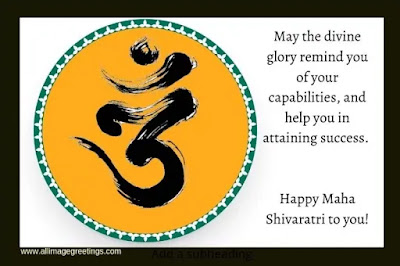




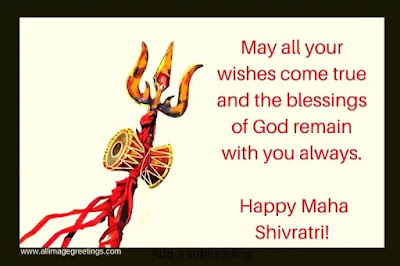
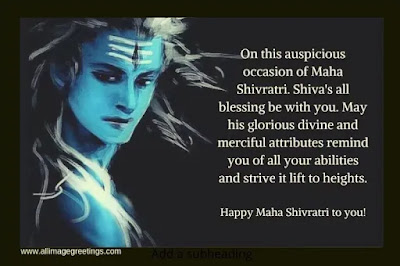
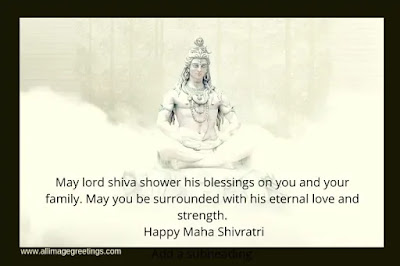


.jpg)


